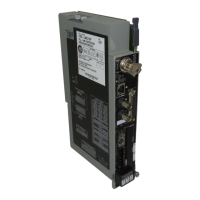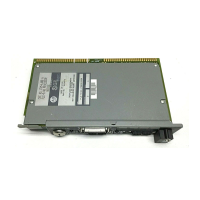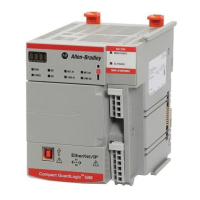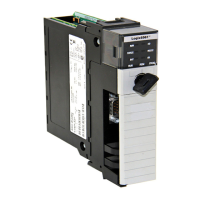
Do you have a question about the Allen-Bradley ControlNet PLC-5 and is the answer not in the manual?
| Manufacturer | Allen-Bradley |
|---|---|
| Network Type | ControlNet |
| Programming Software | RSLogix 5 |
| Product Type | PLC |
| Communication Ports | ControlNet, DH+ |
| Programming Languages | Ladder Logic |
| Operating Temperature | 0°C to 60°C (32°F to 140°F) |
| Relative Humidity | 5% to 95% (non-condensing) |
| Processor Type | PLC-5 Processor |
| Power Supply | 24V DC |
Lists catalog numbers for PLC-5 ControlNet processors.
Explains safety annotations for identifying hazards and precautions.
Specifies environmental conditions and altitude limits for equipment use.
Provides contact information for technical assistance.
Outlines new information and its location in the manual.
Describes the manual's purpose and scope for ControlNet PLC-5 controllers.
Defines the target audience and required background knowledge.
Lists and defines essential ControlNet technical terms.
Lists related publications for PLC-5 controllers.
Lists related publications for ControlNet systems.
Details checks before installing the processor, including package contents.
Provides essential precautions to prevent electrostatic discharge damage.
Illustrates front panel components of the PLC-5/20C processor.
Lists items included in the processor package for verification.
Details safety requirements and handling precautions for lithium batteries.
Explains settings for addressing and EEPROM transfer switches.
Guides on inserting keying bands to prevent module damage during installation.
Details switch settings for DH+ station address and configuration.
Explains selecting the ControlNet network address using rotary switches.
Details the procedure for installing a remote I/O link.
Provides guidelines for DH+ link cable lengths.
Emphasizes the need to purchase ControlNet taps from Rockwell Automation.
Explains connecting a PC to the processor for programming via DH+.
Details serial cable usage for programming via Channel 0.
Recommends using the 1786-CP cable for NAP connections.
Lists pin assignments for serial port configurations.
Provides guidelines for RS-422A compatibility and distance restrictions.
Emphasizes installing wiring according to electrical codes.
Explains the design principles of the ControlNet system for I/O transmission.
Explains the role of RPI in establishing data transfer rates.
Details the flow of scheduled input data transfer.
Lists supported scheduled data-transfer operations.
Highlights network time reservation for unscheduled transfers.
Warns about potential program scan extension with CIO instructions.
Explains using MSG instructions for peer-to-peer messages.
Illustrates the flow of ControlNet data transfer.
Explains PCSC for scheduled connection types.
States that input data must be mapped to DIF for PCSC.
Provides considerations for using PCSC with analog I/O and PID.
Details allowable combinations of scheduled connection types for I/O adapters.
Lists rules for connections when an exclusive owner is present.
Explains how input devices send data to multiple processors.
Explains how PLC-5 sends output data to multiple targets.
Describes effects on I/O status file bits.
Explains reserving I/O image space for non-ControlNet devices.
Details how processor-resident I/O reserves image space.
Describes image space reservation for non-ControlNet Remote I/O.
Shows maximum I/O map entries allowed per processor.
Emphasizes mapping discrete I/O to I/O image for forcing.
Details ControlNet mapping for 1771 modules.
Details ControlNet mapping for 1747 modules.
Details ControlNet mapping for 1794 Flex modules.
Shows mapping for peer-to-peer communications.
Discusses techniques for efficient I/O mapping.
Explains how node addresses map to I/O image tables.
Describes optimizing I/O image table without slot complementary.
Describes optimizing I/O image table with slot complementary.
Provides an example of basic I/O image table optimization.
Guides on placing input/output modules for optimization.
Illustrates I/O image space preservation with ControlNet optimization.
Discusses module placement and chassis size for slot complementary.
Shows efficient slot mapping with slot complementary.
Summarizes tradeoffs between optimization methods.
Lists various ControlNet devices compatible with PLC-5.
Clarifies keeper device types and rules for combining them.
Details program file compatibility for conversion to ControlNet.
Warns about incompatibility between different ControlNet phases.
Outlines software used for configuring and programming ControlNet.
Explains differences in I/O configuration between remote I/O and ControlNet.
Guides on verifying that downloaded configuration matches network information.
Details downloading projects solely from RSLogix 5.
Explains the merge-save functionality in RSNetWorx.
Explains using MSG instructions for sending messages.
Explains using MSG for multihop messaging via ControlBus.
Details using the ControlNet I/O Transfer (CIO) instruction.
Lists options for changing command type and data table address.
Explains using continuous mode message instructions.
Introduces IDI and IDO instructions for immediate data transfer.
Illustrates IDI data copying from DIF buffer to data table.
Illustrates IDO data copying from data table to DOF buffer.
Guides on recovering from major faults 200 and 201.
Explains the general status indicators on the processor.
Details the meaning of the PROC indicator states.
Details the meaning of the FORCE indicator states.
Details the meaning of the COMM indicator states.
Explains the status of the I/O indicator.
Explains the status of network indicators A and B.
Table detailing DH+/RIO status indicators, causes, and actions.
Lists software tools for monitoring ControlNet configuration and status.
Details environmental and electrical specifications like temperature, humidity, and immunity.
Covers hardware addressing modes and communication options.
Details keying band positions and product certifications.
Lists specifications for memory, I/O capacity, and scan time.
Details ControlNet and Remote I/O/DH+ specifications.
Provides critical warnings and precautions for hazardous locations.
Details processor status data in S:0-S:2.
Describes active node table information for channel 1A.
Explains global status bits for racks.
Details last and maximum program scan times.
Lists minor faults and battery status.
Details major fault codes and their meanings.
Explains user-defined fault codes and their recovery.
Provides examples of recoverable fault codes and actions.
Provides examples of non-recoverable fault codes and actions.
Lists recoverable faults and corrective actions.
Lists recoverable faults and corrective actions.
Lists recoverable faults and corrective actions.
Lists recoverable faults and corrective actions.
Details minor faults and queue status.
Explains user control bits in S:26.
Details rack control bits for racks 0-7.
Explains setpoints for program watchdog, fault routine, and STI.
Details global status bits and rack fault bits.
Details rack control bits for racks 10-17.
Details global status bits for racks 20-27.
Details rack control bits for racks 20-27.
Explains how to determine memory card type and status.
Details MCP inhibit bits.
Explains MCP file number and scan time status words.
Describes the ControlNet I/O Transfer (CIO) instruction.
Describes MSG instructions for ControlNet networks.
Provides details for the Immediate Data Input (IDI) instruction.
Provides details for the Immediate Data Output (IDO) instruction.
Explains the status words in the ControlNet I/O status file.
Details the bits within the first word of the I/O status file.
Table explaining bits in the first word of the ControlNet I/O status file.
Explains status words based on ControlNet I/O connection type.
Lists ControlNet error codes, causes, and corrective actions.
Explains how fault routines handle major faults.
Guides on clearing faults before continuing process execution.
Lists ControlNet-specific major fault codes and corrective actions.
Lists recoverable faults and their corrective actions.
Details the layout of the ControlNet diagnostic file.
Explains bits in word 23 of the diagnostic file.
Details channel status and media bits in the diagnostic file.
Index entries for numerical catalog numbers.
Index entries starting with A, B, and C.
Covers ControlNet I/O mapping and operations.
Explains ControlNet I/O Transfer (CIO) instructions.
Explains immediate data I/O instructions.
Details ControlNet network and configuration.
Guides on programming and lists relevant publications.
Details steps for configuring the ControlNet system.
Explains discrete I/O data transfer mapping.
Describes distributed keeper functionality.
Guides on downloading software projects.
Information on error codes.
Explains I/O mapping techniques.
Explains ControlNet I/O Transfer (CIO) instructions.
Explains immediate data I/O instructions.
Details ControlNet network and PLC-5 configuration.
Details processor keying and component location.
Covers ladder messaging and multicast features.
Defines NAP and node parameters.
Explains non-discrete I/O data transfer.
Covers PCMCIA card and PCSC settings.
Details verification activities and software usage.
Defines scan list configuration and entry.
Explains scheduled connection types and data transfer.
Defines segment and terminator.
Explains using STIs with ControlNet programs.
Covers DH+ station address and I/O chassis settings.
Details specifying the serial interface.
Provides information on status files and indicators.
Guides on troubleshooting the ControlNet system.











